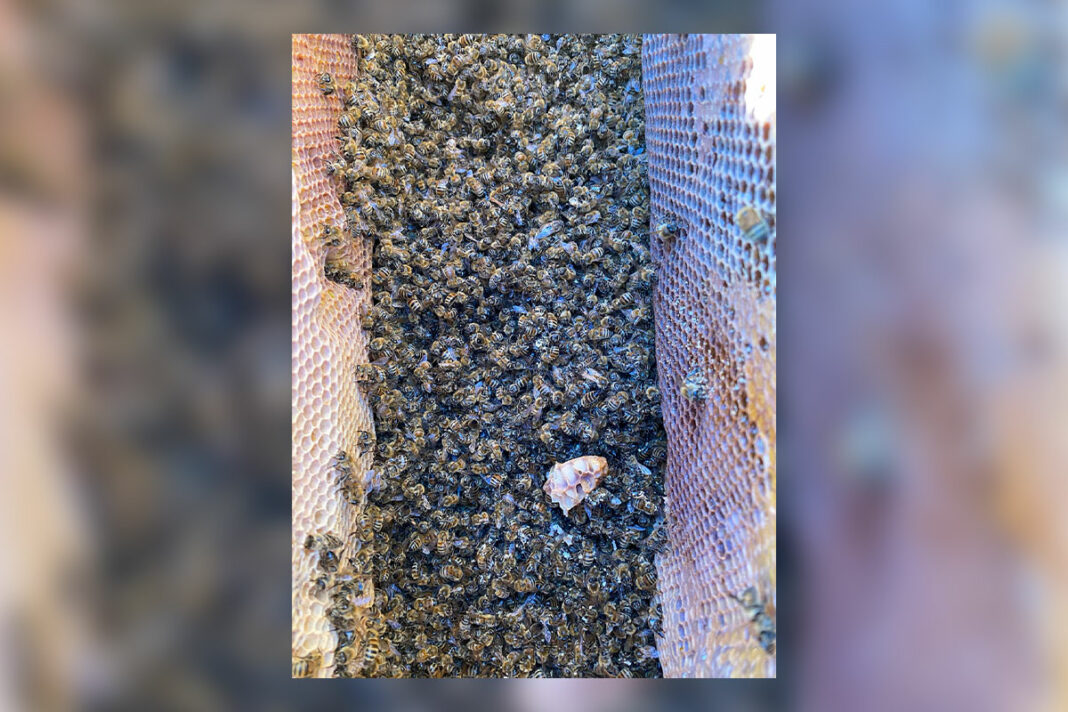MANITOULIN ISLAND—Janice Mitchell, a hobby beekeeper and veterinarian, was preparing her bee colonies for the winter on Manitoulin Island. However, by February Dr. Mitchell faced a devastating surprise: 90 percent of her colonies had perished.
Dr. Mitchell, who had previously maintained an average of 25 colonies, saw her numbers drop to 18 last year. Out of these, 16 colonies were decimated. Historically, her colonies experienced a mortality rate of around 10 percent, but this year’s loss was unprecedented.
“It was my biggest loss. That’s when I knew something had changed,” she explained.
Dr. Mitchell performed necropsies on the dead bees, finding no signs of starvation, mold, moisture issues, wing deformities or significant varroa mite infestation. Seeking answers, she sent samples to the University of Guelph’s Agriculture and Food Laboratory. The results revealed 0.57 milligrams of glyphosate in the dead bees.
Glyphosate, a common herbicide used to control weeds, has been under scrutiny for its impact on bee health. Research from the Pesticide Action Network in Europe indicates that exposure to glyphosate in concentrations between five to ten milligrams can reduce beneficial gut bacteria in honey bees and dysregulate their immune systems. The acceptable level of glyphosate in drinking water for humans is 0.28 milligrams, according to Ontario’s drinking water standards.
Dr. Mitchell was taken aback by the findings. “When I asked for a glyphosate test, I was told the lab had never done that before. How are these chemicals getting approved and why aren’t beekeepers testing for this?” she said.
Glyphosate interferes with the shikimate pathway, a crucial biochemical route used by bacteria, fungi, algae, and plants to produce essential amino acids. This disruption can have profound effects on bee health, affecting their gut microbiome and overall immunity.
Dr. Mitchell is now raising awareness about the dangers of glyphosate and its potential impact on wild bees and pollination. The source of the glyphosate remains unknown, but bees forage within a five-kilometer radius, which includes numerous farm fields using glyphosate-based herbicides like Roundup. Dr. Mitchell is also awaiting a response from Hydro One for a report on their usage of glyphosate in the area.
“Honeybees can be our ‘canaries in the coal mine’ for studying the impact of chemicals on wildlife, as it is challenging to study the effects on other species in the wild. We must assume that honey (nectar) and pollen consumed by both humans and bees may be laced with glyphosate. Bees and mammals, including humans, are not ‘Roundup Ready’ and suffer gut biome damage from glyphosate.”
Paul Kelly, manager of the University of Guelph’s Honey Bee Research Centre, mentioned that while the centre hasn’t observed issues in their hives linked to glyphosate, the possibility of bees encountering unusually high amounts in specific situations can’t be ruled out.
The alarming discovery has parallels elsewhere. CBC News recently reported a similar incident in Lively, where 1.2 million bees at Mikkola Family Farm and Apiary died suddenly. Beekeeper Dawn Lalonde is fundraising for tests and necropsies to pinpoint the cause, suspecting environmental chemicals.
Ian Grant, president of the Ontario Beekeepers’ Association, acknowledged the high mortality rates this year but couldn’t attribute them to a single cause. Ms. Mitchell emphasized the importance of education and research in addressing bee deaths caused by agrochemicals.
“I pass the gauntlet to academia and researchers. This should be taken on and analyzed,” Dr. Mitchell urged. “The loss of pollinators threatens not only the health and diversity of Earth’s ecosystems but also global food security. How do we feed the world without pollinators?”
The persistence of glyphosate varies depending on the environment. In soil, its half-life ranges from a few days to several months, typically averaging around 47 days. In water, its half-life ranges from 12 hours to 91 days. Glyphosate binds tightly to soil particles, reducing its mobility and leaching into groundwater, and its degradation is primarily through microbial activity.
Wetlands play a crucial role in mitigating the impact of glyphosate by filtering and breaking down contaminants before they reach larger bodies of water.
However, recent legislative moves by the Doug Ford government have weakened environmental protections, leading to reduced oversight and conservation of these vital ecosystems. These changes have raised concerns about the increased vulnerability of water bodies and the wildlife they support, including bees.
“If Hydro One provides advance notice of chemical spraying and tags treated areas, forest companies, homeowners, and farmers should do the same. This would highlight the increasing prevalence of these chemicals in our environment,” Dr. Mitchell said.
Glyphosate can disrupt the gut microbiome of honey bees, impair their foraging behavior, and weaken colony health. Other insects, such as butterflies and ladybugs, also suffer from habitat destruction due to glyphosate use, leading to biodiversity loss and ecosystem disruptions.
Dr. Mitchell’s findings have raised critical questions about the regulation and testing of glyphosate. “There is a chemical soup out there. We need to look outside the box and understand the broader environmental impact,” she said.
“The power to promote organic farming practices lies in our consumer choices. By demanding more organic products, we can incentivize farmers to adopt these practices, making organic foods more affordable and widespread.”
Dr. Mitchell’s plea to researchers highlights the urgent need for more comprehensive testing and regulation of agrochemicals to protect bee populations and ensure the health of ecosystems and food security.






